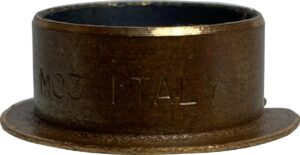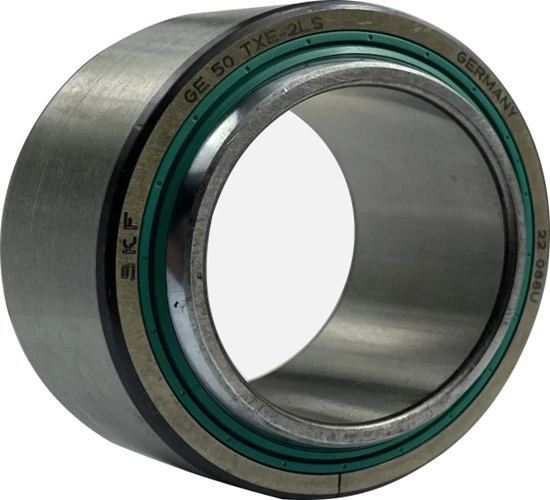Plain and spherical bearings
Startseite » Plain and spherical bearings
Basics, properties and applications
Plain bearings are the counterpart to rolling bearings and, along with them, are among the most frequently used bearings. They are simpler in design and therefore generally less expensive to use. Unlike rolling bearings, in which the shaft is supported on rolling elements that rotate with it, the two components of a plain bearing are in direct contact. This means that two surfaces slide past each other. In contrast to rolling bearings, this type of bearing has no rolling elements that serve to transmit the forces. As a result, there is no rolling friction during operation, but sliding friction.
Plain bearings have a very simple design because they do not contain any moving parts. They can be installed in the housing in two different ways:
Solid (sliding bushing design).
Divided into butt joints (design as sliding shells)
The design of plain bearings also depends on the direction of the forces to be transmitted. Thus, there are radial bearings, i.e. supporting bearings, and thrust bearings, i.e. track bearings. In applications with exclusively radial forces, bushings with a cylindrical shape are sufficient. If axial forces occur in addition to radial forces, so-called flanged bushings must be used. These have a circumferential projection on one side of the cylindrical shape.

Collar Bushing
Various materials are used for plain bearings, with the most commonly used plain bearings being made of metal, plastic or ceramic. Composite bearings, such as metal-polymer plain bearings or fiber-reinforced composite bearings, are also available. In the case of metallic bearings, a distinction is made between monometallic, bimetallic and sintered-metal bearings. The latter are porous, which is why they can be well impregnated with lubricant. In general, it is advantageous if the shaft and bearing are made of different materials. For example, metal-metal pairings are generally only possible with lubrication.
In the case of lubrication, a distinction must be made on the one hand according to the lubricant used (oil lubrication, grease lubrication, water lubrication, dry lubrication or air and gas lubrication) and on the other hand according to the respective type of lubrication (hydrodynamic & hydrostatic lubrication, permanent lubrication, lubricant supply).
Supplementary information: Comparison of plain bearings and rolling bearings
Advantages of plain bearings:
- Often less expensive than rolling bearings
- Usually run quietly, are robust and mostly insensitive to dirt, which is why these rarely require additional seals
- The damping materials of some plain bearing materials make them relatively insensitive to shocks, vibrations and jolts
- The variety of materials enables a wide range of applications, even for difficult requirements
- Require only small radial installation space and are constructively adaptable
- Less complex structure, therefore simple assembly
Disadvantages of plain bearings:
- Higher starting torque cannot be avoided
- Generally have lower efficiency than rolling bearings
- Higher wear at low speeds
Spherical plain bearing and rod end
Spherical plain bearings are ready-to-install machine elements which, due to the spherical design of the sliding surfaces, can accommodate misalignments as a result of rotary, tilting and swiveling movements. Sliding contact takes place between a spherical inner ring and an equally spherical bore in the outer ring. The large contact area makes spherical plain bearings relatively resistant to shocks, impacts and vibrations and makes them suitable for guiding and supporting functions. They are classified as plain bearings rather than rolling bearings.
Plain bearings are available in three different types (radial, axial and angular contact). The choice of the correct type depends on the direction of the acting load.
Many applications require bearing elements that are designed for both swivel and tilting movements and can thus compensate for misalignment. Many rolling bearings cannot meet these requirements because they are designed for continuous circulating movements and can only accommodate misalignments in very limited areas. This is where the great advantage of spherical plain bearings lies. They can compensate for misalignments and axial misalignments and thus prevent edge pressure or edge splitting. Furthermore, compared to angular motion rolling bearings (spherical roller bearings, self-aligning ball bearings), they have the advantage that they require significantly less installation space and are less expensive to purchase.
A rod end is a spherical plain bearing unit consisting of a rod end housing with a built-in spherical plain bearing. A threaded shaft (also rod shaft) is in turn attached to the housing. Rod ends are mainly used in lever and linkage connections or in the pneumatics and hydraulics industry as a connection between cylinder and connection point.
PACH Systems offers you a wide product range of different plain and spherical plain bearings. For this purpose we cooperate with our long-term partners. Please let us know your requirements via our contact form. We will be happy to provide you with a non-binding offer or contact you to discuss the details.




